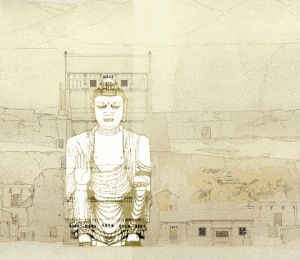Zhenru Zhou, PhD candidate, Department of Art History
“Hexi Buddhist Landscape in the Making: From a Dunhuang Colossal Buddha Image to the Nine-Story Pavilion”
Discussant: Jiayi Zhu, PhD student, Department of East Asian Languages and Civilizations
Friday, May 29, 2020
4:30-6:30 pm, Zoom meeting (please find the registration link below)
Abstract: The colossal Buddha image is one of the major visual elements in the Buddhist landscape across South, Central and East Asia. The Northern Colossal Image (beidaxiang 北大像) of the Mogao Caves (Dunhuang, Gansu), created in 695 CE, is often regarded as such a production of “the Second International Buddhist Style” whose other name is “the Imperial Style of Tang China”. This paper, however, complicates this static view by asking what the Mogao Colossal has visually, physically, and conceptually evolved into since the Tibetan (781-850) and the Guiyijun periods (851-1036). It investigates the ways in which the Mogao Colossal has engaged with the spectacles of Buddhist caves and auspicious images (ruixiang 瑞像) at regional and local scales—namely, along the Hexi or Gansu Corridor, at the Mogao complex, and in the vicinity of the Mogao Colossal. I argue that the Mogao Colossal, as the production of a series of image-making and story-telling, was remade for the purpose of reviving and relocating the legendary Buddhist landscape from the ancient Liangzhou (present-day Wuwei, Gansu) to the contemporary Dunhuang. This study examines a variety of visual materials, ranging from medieval and modern visual representations of Buddhist caves and landscapes, to archaeological evidences at the Mogao Caves and the Tiantishan Caves (Wuwei) that were excavated or published at the turn of the 21st century. By critically and creatively engaging with these materials, this study hopes to shed new light on the coming-into-being of the elaborate architectural traditions of the Mogao Caves, as the Mogao Colossal is now more popularly known as “the Nine-Story Pavilion” (jiuceng lou 九层楼).
The vicinity of the Northern Colossal Image Cave, the Mogao Caves (Dunhuang, China). Various sources, photocollage by author.
Zoom Registration Link:
https://uchicago.zoom.us/meeting/register/vpUqd-Gqpj8ilKaC_sf3FR0f5noJHZcNLA
++++++++++++++++++++++++++++
Zhenru Zhou studies religious art and architecture in China and beyond, with a focus on the medieval Buddhist cave-temples in Northern China. She received an M. Arch degree from Princeton University in 2016, and another M. Arch and a B. Arch degree from Tsinghua University (China). Her dissertation project, titled “Between the Virtual and the Real: A New Architecture of the Mogao Caves (Dunhuang, China) in 781-1036 CE,” explores the complexity of cave architecture regarding its hybrid materiality and visuality, construction and reconstruction over time.
Jiayi Zhu is PhD student at the East Asian Languages & Civilizations Department. Her area of study is Medieval China, Japan and Korea. Jiayi received her BA from Middlebury College (Anthropology and Environmental Studies) in 2014, and her MA from Columbia University (East Asian Buddhism) in 2017. Her research focuses on Esoteric Buddhism and Buddhist art in East Asia from 7th to 10th century.
